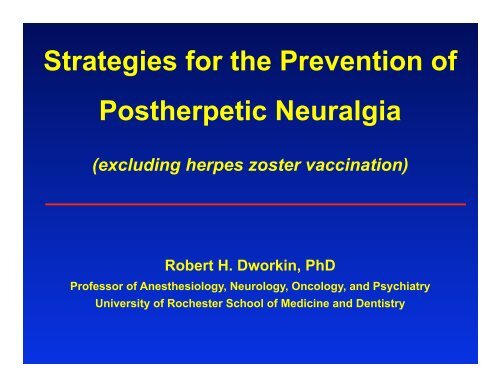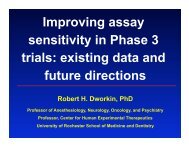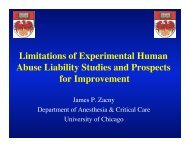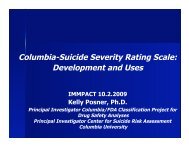Strategies for the Prevention of Postherpetic Neuralgia - immpact
Strategies for the Prevention of Postherpetic Neuralgia - immpact
Strategies for the Prevention of Postherpetic Neuralgia - immpact
Create successful ePaper yourself
Turn your PDF publications into a flip-book with our unique Google optimized e-Paper software.
<strong>Strategies</strong> <strong>for</strong> <strong>the</strong> <strong>Prevention</strong> <strong>of</strong><br />
Pos<strong>the</strong>rpetic <strong>Neuralgia</strong><br />
(excluding herpes zoster vaccination)<br />
Robert H. Dworkin, PhD<br />
Pr<strong>of</strong>essor <strong>of</strong> Anes<strong>the</strong>siology, Neurology, Oncology, and Psychiatry<br />
University <strong>of</strong> Rochester School <strong>of</strong> Medicine and Dentistry
Dorsal horn atrophy, dorsal root ganglion<br />
fibrosis, and loss <strong>of</strong> epidermal nerve fibers<br />
on <strong>the</strong> affected side in PHN<br />
Watson CPN, et al.<br />
Pain, 1988;34:129-138.<br />
Oaklander AL, et al.<br />
Annals <strong>of</strong> Neurology, 1998;44:789-795.
Proportion <strong>of</strong> patients developing PHN:<br />
enrollment<br />
famciclovir vs. placebo<br />
Days following<br />
30 60 90<br />
120 150 180<br />
Patients ≥ 18 yrs<br />
Famciclovir 41.3 38.2 27.9* 24.6*<br />
20.4* 15.0*<br />
Placebo 44.1 39.5 32.7 29.6 26.4 23.8<br />
Patients ≥ 50 yrs<br />
Famciclovir 54.6 50.1 34.9* 28.8*<br />
25.8* 19.5*<br />
Placebo 67.9 61.1 49.2 45.8 42.2 40.3
Risk factors <strong>for</strong> PHN<br />
1. Older age<br />
2. More severe acute pain<br />
3. Greater rash severity<br />
7. Presence <strong>of</strong> a prodrome<br />
8. Female sex<br />
9. Trigeminal distribution<br />
10. Greater sensory abnormalities in <strong>the</strong> affected dermatome<br />
11. Generalized subclinical polyneuropathy<br />
12. More pronounced immune responses<br />
13. HIV infection, organ transplant, connective tissue disease<br />
14. MRI brainstem and cervical cord abnormalities<br />
15. Viremia<br />
16. CSF interleukin 8 concentration (at rash healing)<br />
17. HLA-A haplotype (*3303-B*4403-DRB1*1302)<br />
18. Fever ≥ 38°C
Greater acute pain is a risk factor <strong>for</strong> PHN<br />
1. Riopelle et al. 1984 72<br />
2. Harding et al. 1987 71<br />
3. Dworkin et al. 1992 19<br />
4. Leijon et al. 1993 52<br />
5. Cioni et al. 1994 52<br />
6. Beutner et al. 1995 1141<br />
7. Bruxelle 1995 301<br />
8. McKendrick and Wood 1995 160<br />
9. Whitley et al. 1996 208<br />
10. Wood et al. 1996 316<br />
11. Dworkin et al. 1998 419<br />
12. Meister et al. 1998 635<br />
13. Söltz-Szöts et al. 1998 511<br />
14. Harrison et al. (AIDS) 1999 170<br />
15. Decroix et al. 2000 1897<br />
16. Haanpää et al. 2000 113<br />
17. Tyring et al. 2000 597<br />
18. Zaal et al. 2000 81<br />
19. Scott et al. 2003 165<br />
20. Jung et al. 2004 965<br />
21. Kotani et al. 2004 170
Whitley RJ, Shukla S, Crooks RJ.<br />
The identification <strong>of</strong> risk factors<br />
associated with persistent pain<br />
following herpes zoster.<br />
Journal <strong>of</strong> Infectious Diseases,<br />
1998;178:S71–S75.
If you come to a <strong>for</strong>k in <strong>the</strong> road,<br />
take it.<br />
— Yogi Berra
Is severe acute pain a modifiable<br />
risk factor?<br />
YES<br />
Is severe acute pain a causal risk<br />
factor?<br />
HAS BEEN A REASONABLE HYPOTHESIS,<br />
BUT MAYBE NOT…
Amitriptyline +<br />
acyclovir (n = 9)<br />
Placebo +<br />
acyclovir (n = 17)<br />
Dworkin RH. <strong>Prevention</strong> <strong>of</strong> pos<strong>the</strong>rpetic neuralgia. Lancet, 1999;353:1636-1637.
Preventing PHN by attenuating nerve<br />
damage and acute pain in herpes zoster<br />
VZV<br />
reactivation<br />
Peripheral nerve damage and dysfunction<br />
Acute neuropathic pain<br />
VZV<br />
replication<br />
ANTIVIRAL<br />
THERAPY<br />
ANALGESIA<br />
Acute nociceptive pain<br />
Central<br />
functional and<br />
structural<br />
changes (e.g.,<br />
central<br />
sensitization,<br />
damage from<br />
excitotoxicity)<br />
PHN<br />
Tissue damage and inflammation<br />
VZV = varicella-zoster virus<br />
Dworkin RH, et al. Clinical Journal <strong>of</strong> Pain, 2000;16:S90-S100.
Pain, 2009;142:209-217
mean > 30% response<br />
LS<br />
difference*<br />
CR-oxycodone vs. placebo<br />
days 1-8 -1.26 .01 55 vs. 28% .03<br />
days 1-14 -1.22 .02 79 vs. 45% .01<br />
days 1-28 -.78 .14 86 vs. 76% .32<br />
Gabapentin vs. placebo<br />
days 1-8 -.75 .13 34 vs. 28% .57<br />
days 1-14 -.44 .37 55 vs. 45% .43<br />
days 1-28 .00 >.99 62 vs. 76% .26<br />
*Least squares mean difference between groups in mean daily diary worst pain. Intention-to-treat<br />
analysis with last observation carried <strong>for</strong>ward in patients with at least one post-randomization diary.
Table 2. Corticosteroid and analgesic medications that can<br />
be considered <strong>for</strong> treatment <strong>of</strong> patients with herpes zoster<br />
1. Opioids<br />
or<br />
Tramadol<br />
2. Gabapentin<br />
or<br />
Pregabalin<br />
3. TCAs<br />
{Oral<br />
corticosteroids}<br />
Dworkin RH, Johnson RW, Breuer J, Gnann JW, Levin MJ, Backonja M, et al.<br />
Clinical Infectious Diseases, 2007;44(suppl 1):S1-S26.
Preventing PHN by attenuating nerve<br />
damage and targeting <strong>the</strong> TS in zoster<br />
VZV<br />
reactivation<br />
Peripheral nerve damage and dysfunction<br />
Acute neuropathic pain<br />
VZV<br />
replication<br />
ANTIVIRAL<br />
THERAPY<br />
BOTTS<br />
PHN<br />
Acute nociceptive pain<br />
Tissue damage and inflammation<br />
VZV = varicella-zoster virus<br />
Dworkin RH, et al. Clinical Journal <strong>of</strong> Pain, 2000;16:S90-S100.
BOTTS (blockers <strong>of</strong> <strong>the</strong> transition state)<br />
1. Glial cell modulators (PPF, AV-411)<br />
2. GCH1 inhibitors<br />
3. Pain sensitivity<br />
4. Catastophizing<br />
5. Expectations
Shingles Trial <strong>of</strong> Oral Medication to Prevent<br />
Pos<strong>the</strong>rpetic <strong>Neuralgia</strong> (STOMP-PHN)<br />
• Morphine or matching placebo <strong>for</strong> 28 days in herpes<br />
zoster patients all treated with famciclovir beginning<br />
within 5 days <strong>of</strong> rash onset.<br />
• Primary endpoint: incidence <strong>of</strong> PHN defined as presence<br />
<strong>of</strong> any pain in <strong>the</strong> affected dermatome 120 days after rash<br />
onset.<br />
• 95% power to detect a reduction in <strong>the</strong> incidence <strong>of</strong> PHN<br />
from 25% in <strong>the</strong> placebo group to 12.5% in <strong>the</strong> morphine<br />
group (80% power to detect a reduction <strong>of</strong> 25% to 15%).<br />
• Requires 250 patients per group, inflated to 300 patients<br />
per group to account <strong>for</strong> <strong>the</strong> anticipated 16% withdrawal<br />
rate.<br />
• Total sample size = 600 patients.
Shingles Trial <strong>of</strong> Oral Medication to Prevent<br />
Pos<strong>the</strong>rpetic <strong>Neuralgia</strong> (STOMP-PHN)<br />
• Morphine or matching placebo <strong>for</strong> 28 days in herpes<br />
zoster patients all treated with famciclovir beginning<br />
within 5 days <strong>of</strong> rash onset.<br />
• Primary endpoint: incidence <strong>of</strong> PHN defined as presence<br />
<strong>of</strong> any pain in <strong>the</strong> affected dermatome 120 days after<br />
rash onset.<br />
• 95% power to detect a reduction in <strong>the</strong> incidence <strong>of</strong> PHN<br />
from 25% in <strong>the</strong> placebo group to 12.5% in <strong>the</strong> morphine<br />
group (80% power to detect a reduction <strong>of</strong> 25% to 15%).<br />
• Requires 250 patients per group, inflated to 300 patients<br />
per group to account <strong>for</strong> <strong>the</strong> anticipated 16% withdrawal<br />
rate.<br />
• Total sample size = 600 patients.
Primary endpoints <strong>for</strong> PHN prevention RCTs:<br />
1. Any pain 4 (or 6) months after rash onset.<br />
2. Pain intensity (e.g., 0-10 scale) 4 (or 6) months<br />
after rash onset.<br />
3. Clinically significant pain (e.g., ≥ 3/10) 4 (or 6)<br />
months after rash onset.<br />
4. Time to resolution <strong>of</strong> any zoster-associated pain<br />
(ZAP).<br />
5. Time to resolution <strong>of</strong> clinically significant ZAP.<br />
6. Area under a pain intensity-by-duration curve.<br />
7. Area under a “truncated” pain intensity-byduration<br />
curve (e.g., Oxman burden <strong>of</strong> illness).
1. Topical local anes<strong>the</strong>tics<br />
2. Subcutaneous local anes<strong>the</strong>tics<br />
and corticosteroids<br />
3. Sympa<strong>the</strong>tic blocks<br />
4. Epidural blocks<br />
5. O<strong>the</strong>r invasive interventions
“As most studies were uncontrolled and <strong>of</strong>ten <strong>of</strong><br />
limited size, we cannot conclude that <strong>the</strong><br />
interventions resulted in a lower incidence <strong>of</strong> PHN<br />
than could be expected from <strong>the</strong> natural course <strong>of</strong><br />
pain in HZ.<br />
Moreover, differences in endpoints, PHN definition,<br />
and inclusion and exclusion criteria make <strong>the</strong><br />
results <strong>of</strong> <strong>the</strong> studies almost impossible to<br />
compare.”<br />
—Opstelten, van Wijck, Stolker, 2004
van Wijck AJM, et al. Lancet, 2006;367:219-224.
Katz J, McDermott MP, Cooper EM, Wal<strong>the</strong>r RR, Sweeney EW, Dworkin RH. Psychosocial risk factors<br />
<strong>for</strong> pos<strong>the</strong>rpetic neuralgia: a prospective study <strong>of</strong> patients with herpes zoster.<br />
Journal <strong>of</strong> Pain, 2005;6:782-790.








